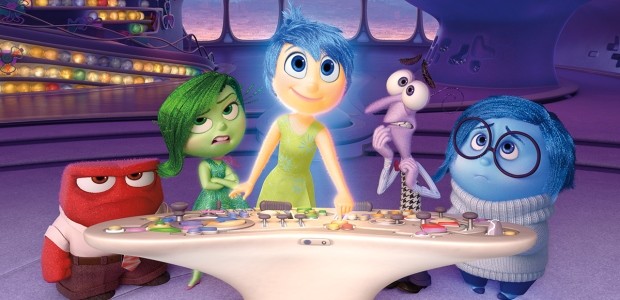Ever been told never to let your emotions get the best of you? Now what if you could actually see and hear those emotions emote. Welcome to Inside Out, a remarkable animation that is as original and clever as it is compelling and poignant. Simply put, another masterpiece from Pixar/Disney’s library of outstanding animations.
From the Academy Award winning Toy Story franchise to the Academy Award winning Up (2009), the mechanism behind Pixar’s storytelling prowess has always been its ability to engage children and adults simultaneously. Inside Out works pretty much the same way but on a whole new level that uses relatable metaphors to tell the story. Set inside the mind of young Riley (voice by Kaitlyn Dias), we follow her mood swings when her parents decide to move from snowy Minnesota to sunny San Francisco. Determining the outcome of her actions are emotions, each colour-coded and manifested as characters – bright and radiant Joy (Amy Poehler), blue Sadness (Phyllis Smith), purple Fear (Bill Hader), green Disgust (Mindy Kaling) and flaming red Anger (Lewis Black). While influencing Riley’s decisions, these emotions also preserve her memories (based on her actions) in coloured orbs relating to a specific emotion. In turn, each stored memory (or core memory) shapes her personality. Everything happens in “Headquarters” or Riley’s consciousness where each of her emotions strive for control over her actions. So on her first day at a new school, Riley is overcome with ‘mixed emotions’, brought on by a struggle between Joy and Sadness. It’s an astute moment in the film that literally defines the word ‘nostalgia’. But then something goes wrong, sending dominant emotions Joy and Sadness into Riley’s sub consciousness. Now left with just three emotions, Riley begins a dangerous descent into depression with Fear, Anger and Disgust wreaking havoc on her personality.
Kicking the film into high gear is the ensuing roller-coaster ride where Joy and Sadness try to get back to Headquarters. It’s also where we are introduced to other characters and instances residing in Riley’s deepest memories. As such, prepare for Bing Bong (Richard Kind), Riley’s imaginary friend and one of the most charming characters in the film, whose inclusion results in a pivotal yet heart wrenching plot point in the story. Such is the powerfully overwhelming nature of this film, often leaving us stranded between Riley’s fondest memories and the manifestation of painful new ones as she grows older. Perhaps one of the greatest achievements of this film is the reiteration that the magic and innocence of youth will inevitably fade away, only to be replaced with the harsh and often cynical trappings of adult perceptions. It’s the same reason why Santa Claus is nothing more than a childhood fantasy.
Co-written and helmed by Up director Pete Doctor, Inside Out is packed with such metaphors and many more that adults will relate to. A thrilling segment where Joy, Sadness and Bing Bong must board a ‘Train of Thought’ to save Riley is just one of Doctor’s clever puns, and as it turns out, comes loaded with comical shenanigans to keep younger viewers rollicking in their seats. Clearly, there’s a lot of backend study into psychology and behavioral science, but the way it all unfolds on screen is the work of pure genius and the type that will leave you in awe – laughing one moment and speechless the next, while stifling a tear drop all through to the end.
Rating: 




